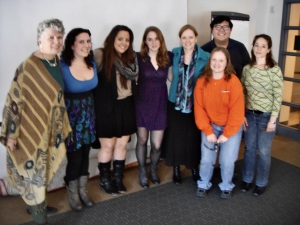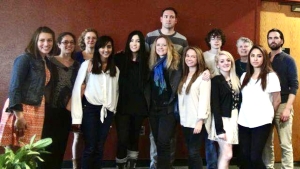Tribute to Minnie Bruce Pratt

Tribute to Minnie Bruce Pratt
Peitho Volume 26, Issue 2, Winter 2024
Author(s): Eileen E. Schell
Eileen E. Schell is Professor of Writing and Rhetoric and L. Douglas and Laura J. Meredith Professor of Teaching Excellence and Faculty Affiliate in Women’s and Gender Studies. Schell is the author of seven books and co-edited collections and many articles, which have examined the intersections of food rhetorics and agricultural literacies, feminist rhetorics, and academic labor, among other subjects.
Tags: anti-racist, creative nonfiction, feminist, in memoriam, Leslie Feinberg, LGBTQ+ activist, Revolutionary Communist
a group of eight people smiling and standing in front of a white wall. Minnie Bruce Pratt is on the far left, and Eileen Schell is the fifth person from the left.
Brilliance. Generosity. Warmth. Revolutionary Communist, Anti-Racist, Feminist Consciousness. All of these qualities were on full display any time Dr. Minnie Bruce Pratt was in the room. Many of us know Minnie Bruce as a renowned feminist, poet, essayist and activist; I had the good fortune of being her colleague at Syracuse University 2005-2014; I also was fortunate to serve as her Department Chair from 2007-2012.
I first met Minnie Bruce when she came to Syracuse, NY to give a poetry reading at the YMCA Downtown Writers’ Center. Star-struck, I listened to her read her poetry and approached the podium with a book for her to sign. I found her to be warm and approachable. After the reading, my colleague Margaret Himley strategized with me about bringing Minnie Bruce to Syracuse as a colleague, and she worked tirelessly to make that happen. Upon arrival at Syracuse University, Minnie Bruce was jointly appointed in the Departments of Writing Studies, Rhetoric, and Composition and Women’s and Gender Studies at SU. She was centrally involved in the 2006 launch of the LGBTQ Studies Program in the College of Arts and Sciences. She taught courses across all three areas and immediately drew a following of students.
Minnie Bruce’s courses changed lives and changed consciousness. Her cross-listed WRT 422/QSX 400 course “Stranger than Fiction: LGBT Creative Nonfiction” asked students to respond to the question: “The hidden facts and unspoken truths of life can sometimes be ‘stranger than fiction’—and when that is so, how do we write believably and convincingly about those complex realities?” (“Syllabus” 2014). Students read LGBTQ creative nonfiction and wrote creative nonfiction on themes of bodies, genders, and sexualities. She also taught a remarkable interdisciplinary advanced Creative Nonfiction course at the graduate/undergraduate level labeled WRT 438/CCR 638/WGS 600 Advanced Creative Nonfiction: “Writing In-Between” that took place over a two-week intensive Maymester session. The course was set up around “tracking the answer to a burning question” through creative nonfiction (“Syllabus” 2015). Populated by a mix of undergraduate students, graduate students across disciplines, faculty, staff and community members, the course enabled so many to work on figuring out their writing projects through creative nonfiction. I took her class the last summer it was taught and saw first-hand the incredible camaraderie and investment that people had in each other’s work. These courses were more than writing courses; they were communities of writers and activists who wrote, supported each other (see Navickas). Writers often ended up publicly sharing their work in the Department of Writing Studies, Rhetoric and Composition Nonfiction Reading series. Minnie Bruce was instrumental in helping me start this series in 2008 when she headlined the Department’s Spring Conference “What is Nonfiction?” along with Judith Kitchen.
In addition to her pivotal teaching, Minnie Bruce was on the frontlines of almost every major campus and community protest in Syracuse. She and her partner Leslie Feinberg were active in labor struggles, anti-racist, and queer liberation movements across the country and world. Minnie Bruce served as a journalist and managing editor of Workers World/Mundo Obrero newspaper. When I was Chair, I remember her sitting in my office with a stack of Workers World, sharing her latest pieces. Her work as a journalist was on top of all the organizing, teaching, writing, and workshops she was doing at Syracuse and elsewhere. As she shared on her website: “The struggle—for social justice and for workers and oppressed people, against racism and imperialism and for liberation for women and all gender and sexually-oppressed people—is my life” (“La Lucha”). She lived those words daily.

a group of thirteen people standing together and smiling in front of a dark red wall. They are in two rows: six in the front and seven in the back. Eileen Schell is the third person from the left in the front row. Minnie Bruce Pratt is the second person from the right in the back row
None of us in Syracuse were ready for the news of Minnie Bruce’s illness and death. We had watched her care for Leslie through the advanced stages of Lyme disease until hir death in 2014. We had attended Minnie Bruce’s remarkable retirement party in 2015, which featured readings by some of her creative nonfiction students. It was inconceivable that less than ten years after Leslie passed away that Minnie Bruce would pass away from glioblastoma.
At her “Celebration of Life” service on September 30, 2023 at the May Memorial Society in Syracuse, I met her two sons, grandchildren, chosen Syracuse family, former students, and comrades. Infused in that event was the community that Minnie Bruce and Leslie had built together. All of us were given the opportunity to carry away a memento in the form of a pair of clip-on earrings. Minnie Bruce did not have pierced ears, but she loved wearing clip-on earrings, and she had a huge collection for all occasions. As I stood with colleagues and friends looking at the trays of her earrings, we reminisced about Minnie Bruce: her colorful scarves, stylish hats, smile, laugh, wise advice, revolutionary writing, and activism. We talked about the electric energy in the air in her classes, readings, writing, activism, and her stories about growing up in Alabama. I carried away a pair of Minnie Bruce’s simple silver spiral earrings, which symbolize to me her beautiful, revolutionary spirit and life that touched and fortified so many of us for the struggles ahead.
Works Cited
“La Lucha: The Struggle.” Minnie Bruce Pratt website.https://minniebrucepratt.net/the- https://minniebrucepratt.net/the-struggle-la-lucha/. Accessed 30 October 2023.
Navickas, Kate. “The Limitations of Liberation in the Classroom: Lessons from Minnie Bruce Pratt.” Pedagogy, vol. 20, no. 1, 2020, pp. 49–58.
“Syllabus: WRT 422/QSX 400: Studies in Creative Nonfiction,” Fall 2014, Syracuse University.
“Syllabus: WRT 438/CCR 638/WGS 600 Advanced Creative Nonfiction: “Writing In-Between,” Maymester 2015, Syracuse University.
 PDF
PDF